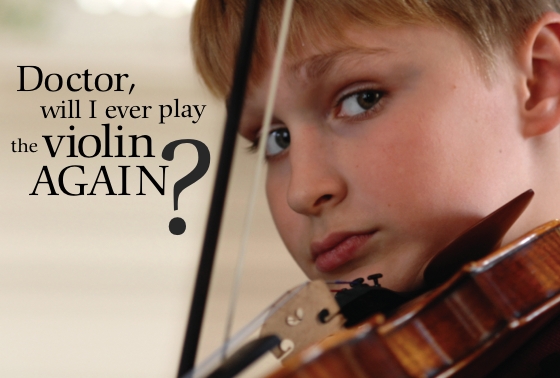Although 9-year-old William Ross has been playing violin for six years, he has
recently discovered the “cool factor” of electric guitar. And in his studded leather belt, aviator sunglasses and
black Converse sneakers, anyone can tell that this third grader was born to
rock.
But on a Sunday afternoon last August, William’s ability to play guitar or even the violin was put in jeopardy.
William’s parents were grilling pork chops on the deck just off the kitchen of their
Hendersonville, Tenn., home, while he was inside making a sandwich for his
school lunch the next day. The serrated metal knife he was using to spread
mayonnaise and cut off the crusts seemed unthreatening enough, especially
because, as William explains, “I’m a Boy Scout. I have knife skills.”
But as he drew the knife across a paper towel in his left palm to clean off the
mayonnaise, his fingers curled around the blade, and it sliced into his middle,
ring and pinkie fingers.
William’s father, Charles Ross, M.D., former director of Endovascular Surgery at
Vanderbilt Medical Center, and his older sisters Julia and Margaret rushed to
his side.
“I was finishing up the pork chops, and I hear screaming from the girls and
William,” recalled Kim Ross, William’s mother. “Blood was spurting everywhere. It was like a little geyser. We couldn’t contain it.”
Once Charles saw the extent of the injury, he decided to bypass the local
emergency room and head straight for the Monroe Carell Jr. Children’s Hospital at Vanderbilt.
No man’s land
Kim said she knew something was wrong because William could open his hand but
not close it.
“He has been playing violin since he was very young and is nearly into Suzuki
Book Four, and I saw that totally go out the window,” she said.
William cut his hand in an area surgeons call “no man’s land.”
“Before World War II, doctors didn’t advise even attempting surgery in the area. They just didn’t succeed,” explained William’s surgeon, Wesley Thayer, M.D., Ph.D., assistant professor of Plastic Surgery. “William lacerated one of the main tendons in the ring finger, and if it went
unrepaired or was inadequately repaired, it would result in the inability to
move the digit.”
For William, the inability to move the digit would mean no violin or guitar.
Thayer, however, had a radical plan involving a new suture and special therapy
that allowed William to regain full function of his hand.


